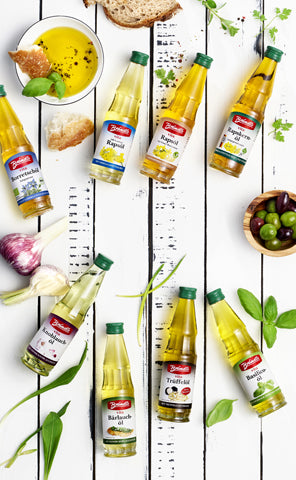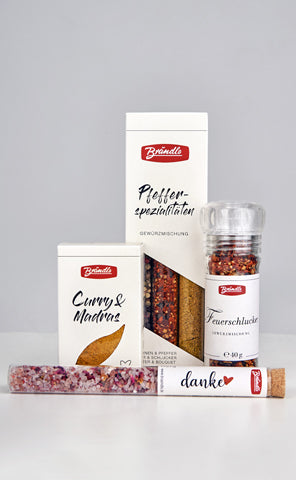
Questions and answers
Any questions?
Here you will find answers to your questions about our Brändle oils.
1. what is the difference between cold pressed and refined oils?
Cold-pressed edible oils are produced from suitable and carefully treated seeds, germs or fruits. They are obtained exclusively by mechanical processes without the addition of heat. They are not degummed, (partially) deacidified, bleached, deodorized and/or fractionated. Decantation, filtration and/or centrifugation are commonly used to remove turbidity. Filtration is accomplished with paper, cloth filters or other filter aids. Refined edible oils are degummed, deacidified and deodorized. They may be bleached and/or fractionated (winterized). Partially refined edible oils are those which have undergone only some of the above processing steps (e.g. degummed). During refining, accompanying substances that may have an influence on the quality of the products are removed. The main issues here are taste, shelf life, technical processing, odor and color. As a result, the oil becomes almost odorless, tasteless and has a longer shelf life. As a result, it can be used in a variety of ways. These oils are excellent for steaming, boiling, baking, frying and deep-frying.
2. are essential fatty acids (omega-3 and/or omega-6 fatty acids) lost during refining?
Refining does not change the fatty acid composition of the edible oil.
3. what are omega-3 and omega-6 fatty acids?
The human body can produce all the fatty acids it needs itself, with the exception of the polyunsaturated fatty acids linoleic acid (omega-6) and alpha-linolenic acid (omega-3). These essential fatty acids must be ingested with food.
In most foods, the content of linoleic acid is significantly higher than that of alpha-linolenic acid. It is known that omega-3 fatty acids have an anti-inflammatory effect and thus play a role in various diseases. It is therefore important to include foods rich in omega-3 fatty acids in the diet. The German Nutrition Society (DGE) recommends a ratio of omega-6 to omega-3 fatty acids of 5:1.
4. which vita oils are high in omega-3 fatty acids?
The vita linseed oil has the highest proportion of omega-3 fatty acids with approx. 52 g/100 ml, the organic vita hemp oil with approx. 18 g/ 100 ml and the vita walnut oil with approx. 11 g/100 ml. The vita rapeseed oil has 8g/100ml.
5. does linseed oil become unhealthy if it is bitter and not refrigerated?
Linseed oil becomes slightly more bitter from day to day. This means that the fresher (younger) a linseed oil is, the less bitter substances it contains. This process could only be stopped or slowed down by "deep freezing". In practice, it will be difficult (rather impossible) to establish a cold chain for linseed oils and to sell the product in retail from the refrigerated counter or freezer. However, the increase in bitter substances does not affect the "effectiveness" of this high-quality oil. The amount of omega-3 fatty acids does not decrease, it just becomes more bitter. This should not be confused with rancid or spoiled. All attempts by seed growers and manufacturers to "eliminate" bitter substances in production or to prevent their formation have been unsuccessful in the last 20 years up to the present day.
6. how long can linseed oil be stored if the bottle is already opened?
We also recommend to store the linseed oil unopened in the refrigerator and to use it up within 4-6 weeks after opening.
7. up to what temperatures can the oils be heated?

8. how to store oils properly?
We recommend to store our oils in a cool and dark place.
9. what is the difference between canola oil and rapeseed oil?
Our refined rapeseed oil is called "rapeseed oil". The cold-pressed rapeseed oil has the name "rapeseed oil". Both oils are pressed from the rape seeds.
10. which oils are suitable for baby food?
Only refined oils should be used for baby food, such as our vita rapeseed oil.
11. why do some oils form flakes when stored in a cool place?
Some oils, such as olive oil and peanut oil, form streaks and/or flakes at lower temperatures. This is due to the natural accompanying substances (waxes) and the fatty acid composition. Different fatty acids become solid at different temperatures. Since natural oils are composed of different fatty acids and waxes, at low temperatures parts remain liquid and others already become solid (flakes, streaks). This process has no influence on the quality. At room temperature, the oils become clear again.
Your question was not there?
Then please feel free to contact us via our contact form.




